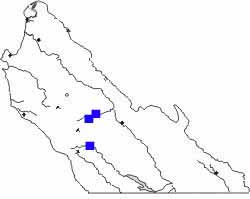|
Emma's Dancer is a colorful, long-legged,
mid-sized dancer that lives next to fast-running rocky streams in the
mountains and foothills.
|
|
|
Males are a lovely shade of violet-purple (for
some reason they remind me of the Minnesota Vikings) that contrasts
with a bright white pruinescence that coverts the underside of the
thorax. There is a very thin mid-dorsal stripe (can look like two
pencil-thin stripes atop the thorax) and a thin black side stripe "that
narrows to a hairline at its midpoint before widening again to a small,
black spot near the base of the forewing" (Manolis 2003).
Photo (very top) 9
Sep 2006 North Fork, San Antonio River
Photos (above & below) 6 Aug 2006 Arroyo Seco River
Males typically perch in a standard spread-legged
posture on rocks or logs jutting above rushing streams (below).
|
|
|
|
|
|
Males have extensive blue over
the 8th, 9th & 10th segments, and a complicated spiky arrangement
to their terminal appendages (right). In the shot above, you can see
the contrastingly white pruinescence to underside of the thorax and
initial abdominal segments.
|

|
Photo (above, full
frame) 23 Sep 2006 near Wagon Caves, The Indians
Photo (above, appendage) 6 Aug 2006 Arroyo Seco
|
|
|
|
Very young Emma's Dancers start out
light tan (above). A female may be brown, or light blue on the thorax,
or even pale green (below). Note the presence of the male-like thoracic
pattern of thin stripes, and the extensive white pruinescence on the
underside of the thorax, the first abdominal segment, and the legs.
|
|
|
|
Photo (immature
above) 14 Aug 2006 Taylor Creek, El Dorado Co.
Photo (female above) 6 Aug 2006 Arroyo Seco
|
|
 Emma's Dancer is restricted in
MTY to rocky, fast-flowing creeks and rivers in the mountains and
foothills (we have no montane lakes, a habitat it uses elsewhere). The
map shows the locales at which it has been found so far. It likely
occurs
widely on similar streams throughout the Santa Lucia Mountains. Emma's Dancer is restricted in
MTY to rocky, fast-flowing creeks and rivers in the mountains and
foothills (we have no montane lakes, a habitat it uses elsewhere). The
map shows the locales at which it has been found so far. It likely
occurs
widely on similar streams throughout the Santa Lucia Mountains.
In MTY, the known flight dates stretch from
5 May to 23 September. Elsewhere in California, flight dates range from
March through September (Manolis 2003).
|
|
Literature cited:
- Manolis, T. 2003. Dragonflies and Damselflies of
California. Univ. of Calif. Press, Berkeley.
Web resources:
Major identification web sites with much information on California
odes include:
For sites with excellent photos to compare for identification or to
simply
enjoy, see:
Many of these sites have links to other useful pages. Kathy Biggs's
site
is particularly useful in her selection of links. |
